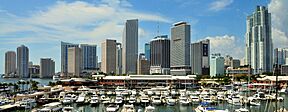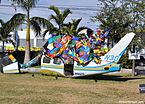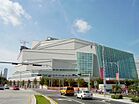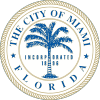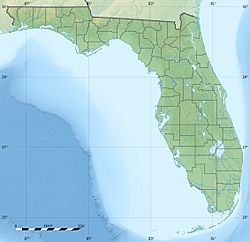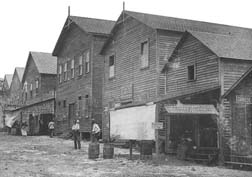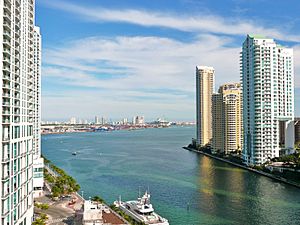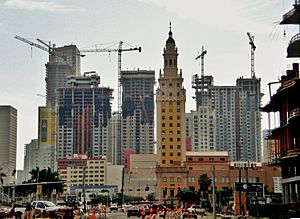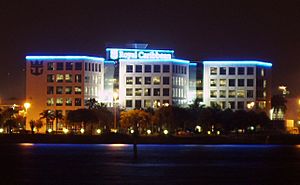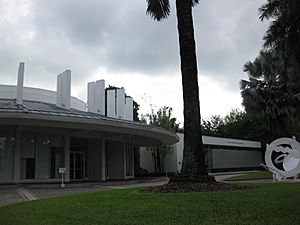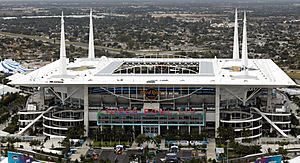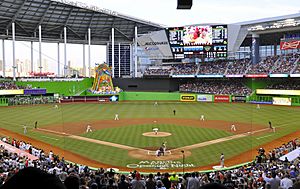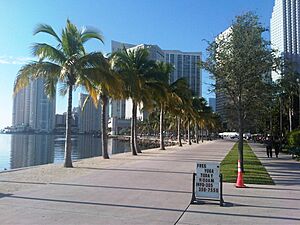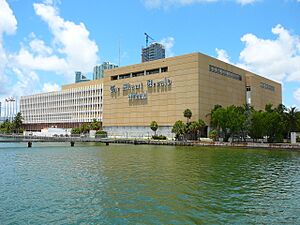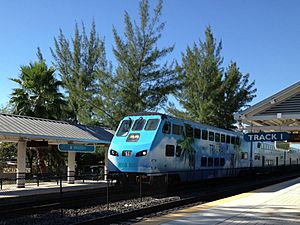Miami facts for kids
Quick facts for kids
Miami
|
|||||
|---|---|---|---|---|---|
|
|||||
| Nicknames:
The 305, Magic City, Gateway to the Americas, Gateway to Latin America, Capital of Latin America and Vice City
|
|||||
| Country | |||||
| State | |||||
| County | |||||
| Settled | After 1858 | ||||
| Incorporated | July 28, 1896 | ||||
| Founded by | Julia Tuttle | ||||
| Named for | Miami River, ultimately derived from Mayaimi | ||||
| Government | |||||
| • Type | Mayor–Commission | ||||
| Area | |||||
| • Total | 56.07 sq mi (145.23 km2) | ||||
| • Land | 36.00 sq mi (93.23 km2) | ||||
| • Water | 20.08 sq mi (52.00 km2) | ||||
| • Metro | 6,137 sq mi (15,890 km2) | ||||
| Elevation | 6 ft (1.8 m) | ||||
| Highest elevation | 42 ft (12.8 m) | ||||
| Population
(2020)
|
|||||
| • Total | 442,241 | ||||
| • Estimate
(2023)
|
455,924 | ||||
| • Rank | 43rd in the United States 2nd in Florida |
||||
| • Density | 12,284.47/sq mi (4,743.55/km2) | ||||
| • Urban | 6,077,522 (US: 4th) | ||||
| • Urban density | 4,884.8/sq mi (1,886.0/km2) | ||||
| • Metro | 6,091,747 (US: 9th) | ||||
| Demonym(s) | Miamian | ||||
| GDP | |||||
| • Metro | 3.674 billion (2023) | ||||
| Time zone | UTC−05:00 (EST) | ||||
| • Summer (DST) | UTC−04:00 | ||||
| ZIP Codes |
33101–33102, 33106, 33109, 33111–33112, 33114, 33116, 33119, 33122, 33124–33138, 33140–33147, 33149–33158, 33160–33170, 33172–33199, 33206, 33222, 33231, 33233–33234, 33238–33239, 33242–33243, 33245, 33247, 33255–33257, 33261, 33265–33266, 33269, 33280, 33283, 33296, 33299
|
||||
| Area code(s) | 305, 786, 645 | ||||
| FIPS code | 12-45000 | ||||
| GNIS feature ID | 277593, 2411786 | ||||
Miami, often called the City of Miami, is a vibrant city on the coast of Florida, in the United States. It is the main city in Miami-Dade County and a big part of the Miami metropolitan area. This larger area is home to over 6 million people, making it one of the biggest in the U.S.
With about 442,000 residents, Miami is the second-largest city in Florida. It is famous for its many tall buildings, having one of the biggest skylines in the country. Miami is a key place for business, culture, arts, and international trade. Its economy is the largest in Florida.
Miami is also known as the "Gateway to Latin America" because of its strong connections to countries in Latin America. Many international banks have offices in Downtown Miami. The city's port, PortMiami, is the busiest cruise port in the world, with millions of passengers each year. Miami is a popular tourist spot, attracting many visitors with its beaches, cultural events, and lively atmosphere.
Contents
- What's in a Name? Miami's Meaning
- Miami's Past: A City's Journey
- Miami's Location and Landscape
- Who Lives in Miami?
- Miami's Economy: A Global Hub
- Miami's Culture and Arts
- Sports in Miami
- Parks and Beaches
- Learning in Miami: Schools and Universities
- Media in Miami
- Getting Around Miami
- Miami's Global Connections
- Images for kids
- See also
What's in a Name? Miami's Meaning
Miami got its name from the Miami River. This river was named after the Mayaimi people, who were Native Americans living around Lake Okeechobee. People sometimes call Miami by fun nicknames like The 305 (after its area code), Magic City, and Capital of Latin America.
Miami's Past: A City's Journey
For thousands of years, Native American tribes lived in the Miami area. The Tequesta people were here for a thousand years before Europeans arrived. An ancient village, dating back to 500–600 B.C., was found near the mouth of the Miami River.
In 1566, a Spanish explorer named Pedro Menéndez de Avilés claimed the land for Spain. A Spanish mission was built there a year later. Over time, Spain and Great Britain controlled Florida, until Spain gave it to the United States in 1821. In 1836, the U.S. built Fort Dallas to help develop the Florida Territory. The Miami area saw fighting during the Second Seminole War.
Miami is special because it's "the only major city in the United States started by a woman," Julia Tuttle. She was a citrus grower from Cleveland. In the late 1800s, people saw the area as a promising place to build. A big freeze in 1894–95 helped Miami grow, as its crops were the only ones in Florida that survived. Julia Tuttle then convinced Henry Flagler, a railroad owner, to extend his Florida East Coast Railway to the area. Because of her efforts, she is known as "the mother of Miami." Miami officially became a city on July 28, 1896, with just over 300 people.
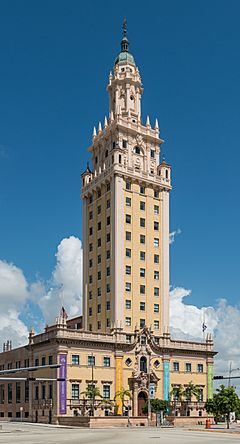
African American workers played a very important part in building Miami. In the early 1900s, people from the Bahamas and African Americans made up 40 percent of the city's population. However, their communities faced unfair treatment and were limited to small areas. Laws at the time also created segregation, meaning different groups of people were kept apart.
Miami grew quickly in the 1920s, with more people and new buildings. But this growth slowed down after the Florida land boom of the 1920s ended, a big hurricane hit in 1926, and the Great Depression began in the 1930s. When World War II started, Miami became an important base for the U.S. military. By 1940, the city's population had grown to over 172,000 people.
After 1959, many people from Cuba came to Miami seeking safety, which further increased the city's population. Miami continued to grow as a major international city. The city's fast growth led to its nickname, The Magic City. Visitors in the winter would say the city grew so much each year it was like magic!
Miami's Location and Landscape
Miami and its surrounding areas are located on a flat plain. To the west are the Everglades, a large wetland, and to the east is Biscayne Bay. The land in Miami is very low, usually only about 6 feet (1.8 meters) above sea level. The highest natural point is in Coconut Grove, about 24 feet (7.3 meters) above sea level. The Gulf Stream, a warm ocean current, flows close to the coast. This helps keep Miami's climate warm and mild all year.
Underneath Miami is a natural underground water source called the Biscayne Aquifer. Most of Miami gets its drinking water from here. Because of this water, it's hard to dig deep underground in the city. This is why Miami's public transportation systems are built above ground.
Miami is one of the smaller major cities in the U.S. in terms of land area. It covers about 35.67 square miles (93.23 square kilometers) of land. This makes it one of the most densely populated cities in the country.
Miami's City Areas
Miami is divided into different sections: North, South, West, and Downtown.
Downtown and East
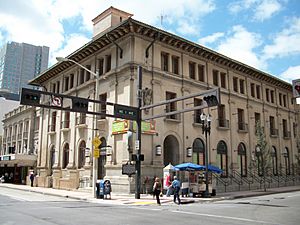
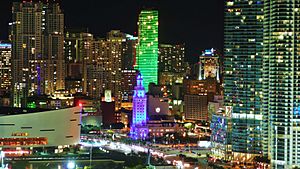
The heart of the city is Downtown Miami, located on the eastern side. This area includes Brickell, Virginia Key, Watson Island, and PortMiami. Downtown is the main business area of South Florida. It has many international banks along Brickell Avenue. Downtown is also home to major companies, cultural spots, and a growing number of homes. Just east of Downtown, across Biscayne Bay, is South Beach, famous for its beaches and nightlife. Northwest of Downtown is the Civic Center, where many hospitals and research centers are located, including Jackson Memorial Hospital.
Southern Miami
The southern part of Miami includes Coral Way and Coconut Grove. Coral Way is an old neighborhood with many historic homes and tree-lined streets. Coconut Grove was founded in 1825 and is known for its winding roads and lush trees. It has many parks and gardens, like Villa Vizcaya, and is popular for its shops, restaurants, and lively atmosphere.
Western Miami
The western side of Miami includes Little Havana, West Flagler, and Flagami. These areas are home to many immigrant communities, especially from Central America and Cuba. Allapattah is another neighborhood in this area, known for its diverse cultures.
Northern Miami
The northern part of Miami includes Midtown, Edgewater, and Wynwood. These areas are a mix of cultures and have many high-rise buildings. The Adrienne Arsht Center for the Performing Arts is located here. Wealthier residents often live in Midtown and the Design District. This area also has historic neighborhoods like Little Haiti, Overtown, and Liberty City, which are important to African American and Caribbean communities.
Miami's Weather: Tropical and Sunny
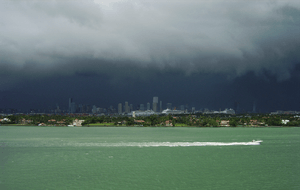
Miami has a tropical monsoon climate, which means it has a dry winter and a wet summer. Its location near the coast and the warm Gulf Stream keep it warm all year. In winter, temperatures are usually between 73°F and 80°F (23–27°C). Cool air sometimes comes in after a cold front, bringing a little rain.
The wet season starts in May and ends in mid-October. During this time, temperatures are usually in the mid-80s to low 90s (29–35°C) with high humidity. However, afternoon thunderstorms or a cool sea breeze often provide relief from the heat. Most of Miami's rain falls during this period.
Miami has never officially recorded snowfall. The warmest temperature recorded was 100°F (38°C) in 1940, and the coldest was 27°F (-3°C) in 1917.
Hurricane season runs from June 1 to November 30. The most likely time for hurricanes to affect Miami is from mid-August to the end of September.
Who Lives in Miami?
Miami is a very diverse city. It is the largest city in South Florida and the main city of the Miami metropolitan area, which has over 6 million people. Miami itself has about 442,241 residents.
The city grew very quickly in the first half of the 1900s. Its population jumped from 1,681 in 1900 to 249,276 in 1950. This made it Florida's largest city for a while.
In the second half of the 1900s, Miami's population growth slowed down as people moved to the suburbs. However, in the 2000s and 2010s, with new high-rise buildings in Downtown, Brickell, and Edgewater, Miami's population started growing fast again.
Miami has a large Hispanic and Latino population. In 2020, about 70% of the city's residents were Hispanic or Latino. Many people from Cuba, Nicaragua, Honduras, and Colombia live in Miami. The city also has communities of people from the West Indies and other parts of the world.
Most people in Miami speak Spanish or English at home. In 2015, about 70% spoke Spanish, and 23% spoke English.
Religion in Miami
Religion in the Miami Metro Area (2014) Protestantism (39%) Catholicism (27%) Mormonism (0.5%) Eastern Orthodoxy (0.5%) Jehovah's Witnesses (1%) Other Christian (1%) No religion (21%) Judaism (9%) Other religion (1%)
In Miami, Christianity is the most common religion, with many people attending Protestant or Catholic churches. There are also communities of Jewish people and followers of other religions. Some people do not identify with any organized religion.
Miami's Economy: A Global Hub
Miami is a major center for business and money, with strong international connections. It's considered a "world city" because of its many global companies. However, some studies show that Miami has lower rates of home ownership and income compared to other U.S. cities.
Many large companies have their main offices in Miami, including Celebrity Cruises, Carnival Corporation, and Norwegian Cruise Line. Over 1,400 international companies have offices in Miami, with many choosing the city for their Latin American operations.
Miami is also a big center for making TV shows, especially for Spanish-language media. Telemundo and UniMás have their main offices here. Miami is also important for music, with Sony Music Latin having its headquarters in the city.
In the mid-2000s, Miami saw a huge building boom, with many new high-rise buildings. This led to fast population growth in areas like Downtown and Brickell. Miami has some of the tallest skyscrapers in Florida.
Miami International Airport and PortMiami are very busy entry points for goods, especially from South America and the Caribbean. PortMiami is the world's busiest cruise port. Miami International Airport is Florida's busiest airport and a major link between the U.S. and Latin America.
PortMiami: World's Cruise Capital

PortMiami is the largest cruise ship port in the world. It has been the top cruise port for over ten years, welcoming the biggest cruise ships and major cruise lines. In 2017, over 5.3 million cruise passengers used the port. It's also one of the busiest cargo ports in the U.S. Many major cruise lines, like Carnival Cruise Line and Royal Caribbean International, have their headquarters in Miami.
Tourism: A Big Part of Miami
Tourism is one of Miami's biggest industries, creating over 144,800 jobs in Miami-Dade County. Miami is often shown in movies and TV shows, making its famous places known worldwide. In 2016, Miami attracted the second-highest number of foreign tourists in the U.S., after New York City. Over 15.9 million visitors came to Miami in 2017, adding billions to the economy.
Miami is a popular place for big events and conferences. Popular tourist spots include South Beach, Lincoln Road, and Bayside Marketplace. The Art Deco District in Miami Beach is famous for its beautiful buildings, beaches, and shopping. Big annual events like the Miami Open and Art Basel bring millions of people to the city every year.
Miami's Culture and Arts
Miami has a lively culture influenced by people from all over the world. It's called the "Magic City" because it grew so fast. It's also known as the "Capital of Latin America" due to its large Spanish-speaking population. Miami has been featured in many video games, like the Grand Theft Auto series, where the fictional "Vice City" is based on Miami.
Entertainment and Shows
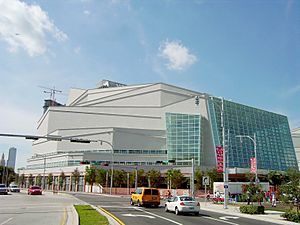
Miami has many places for entertainment, theaters, museums, and parks. The Adrienne Arsht Center for the Performing Arts is a big addition to Miami's arts scene. It's the second-largest performing arts center in the U.S. and hosts operas, ballets, concerts, and musicals from around the world. Other places for shows include the Olympia Theater and the Bayfront Park Amphitheater.
The Miami International Film Festival happens every year, showing independent films from around the world. Miami also has many orchestras and music schools. It's a major fashion center, hosting events like Miami Fashion Week.
Museums and Art
Some of Miami's museums include the Frost Art Museum, Frost Museum of Science, HistoryMiami, and the Pérez Art Museum. The Vizcaya Museum and Gardens is a beautiful historic estate with gardens in Coconut Grove.
Miami's Food Scene
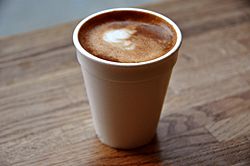
Miami's food is a mix of different cultures, especially from the Caribbean cuisine and Latin American cuisine. This blend, with American food, has created a unique style called Floribbean cuisine. You can find this style of cooking in many restaurants across South Florida.
Cuban immigrants brought popular foods like the Cuban sandwich, medianoche, Cuban espresso, and croquetas. These foods are now a big part of Miami's local culture and can be found everywhere, especially in window cafés. Famous restaurants like Versailles restaurant in Little Havana are Miami landmarks. Miami is also known for its seafood, with many seafood restaurants along the Miami River and Biscayne Bay.
Sports in Miami
Miami is home to five major professional sports teams:
- The Inter Miami CF (soccer)
- The Miami Dolphins (football)
- The Miami Heat (basketball)
- The Miami Marlins (baseball)
- The Florida Panthers (ice hockey)
The Miami Open, a big tennis tournament, is held at Hard Rock Stadium. Miami also has many marinas, jai alai venues, and golf courses. The city has hosted professional car races, including the Miami Grand Prix of Formula One.
The Heat and the Marlins play their games within Miami's city limits. The Heat play at the Kaseya Center in Downtown, and the Marlins play at LoanDepot Park in Little Havana. The Dolphins play at Hard Rock Stadium in nearby Miami Gardens. The Florida Panthers play in Sunrise.
The Orange Bowl, a major college football game, is played at Hard Rock Stadium every winter. Miami has hosted the Super Bowl ten times, more than any other city.
Miami is also home to college sports teams like the University of Miami Hurricanes and Florida International University Panthers. Miami will be one of the U.S. host cities for the 2026 FIFA World Cup.
Parks and Beaches
Miami's tropical weather means you can enjoy outdoor activities all year. The city has many marinas, rivers, bays, canals, and the Atlantic Ocean, making boating, canoeing, sailing, and fishing very popular. The coral reefs in Biscayne Bay are great for snorkeling and scuba diving.
There are over 80 parks and gardens in Miami. Some of the biggest and most popular are Bayfront Park and Museum Park in Downtown, Tropical Park, and Virginia Key.
Other fun places to visit in or near Miami include Zoo Miami, Jungle Island, the Miami Seaquarium, and Fairchild Tropical Botanic Garden.
Learning in Miami: Schools and Universities
Colleges and Universities
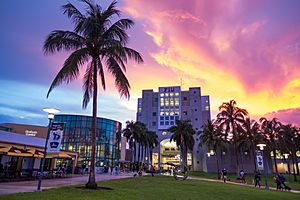
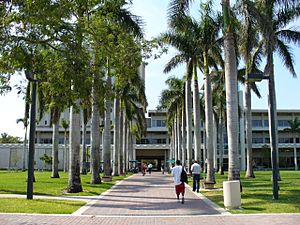
Miami-Dade County has over 200,000 students in its colleges and universities. Some of the largest include Miami Dade College, Florida International University, University of Miami, and Barry University. These schools graduate thousands of students each year.
There are also many organizations in Miami that offer training for different jobs and educational programs.
Schools for Kids
Public schools in Miami are managed by Miami-Dade County Public Schools. This is the largest school district in Florida and the fourth-largest in the United States. It has over 385,000 students and more than 392 schools. The district is very diverse, with students from many different backgrounds.
Some important high schools in Miami include Design and Architecture High School, MAST Academy, and the New World School of the Arts. Miami-Dade Public Schools also offers optional bilingual education in several languages, like Spanish, French, and Mandarin Chinese.
Miami also has many private schools, including Catholic, Jewish, and non-religious schools.
Media in Miami
Miami has one of the largest TV markets in the U.S. The main newspaper is The Miami Herald. For Spanish speakers, El Nuevo Herald is the biggest newspaper. These papers moved their headquarters to Doral in 2013.
Other newspapers include Miami Today and Miami New Times. Many neighborhoods also have their own local newspapers.
Miami is a major center for TV networks and production companies. Telemundo and Univision have their main offices and studios here, producing many shows, including telenovelas. Miami is also important for music recording companies.
Getting Around Miami
Roads and Highways

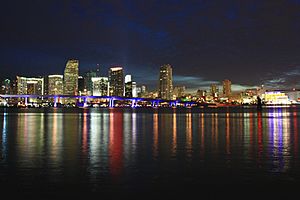
Miami's roads use a special grid system. Flagler Street runs east-west, and Miami Avenue runs north-south. The corner of these two streets is in Downtown Miami. This system helps people find addresses easily. For example, addresses north of Flagler Street and west of Miami Avenue have "NW" in them.
Miami-Dade County has four major interstate highways: I-75, I-95, I-195, and I-395. It also has several U.S. Highways.
Miami has six main causeways that cross Biscayne Bay, connecting the mainland to the islands along the Atlantic Ocean. The Rickenbacker Causeway connects Brickell to Key Biscayne. The Venetian Causeway and MacArthur Causeway connect Downtown to South Beach.
Public Transportation
Public transportation in Miami is run by Miami-Dade Transit and SFRTA. It includes commuter trains (Tri-Rail), elevated trains (Metrorail), and buses (Metrobus). About 17% of Miamians use public transit daily.
Metrorail is an elevated train system with two lines and 23 stations. It connects areas like Hialeah and Kendall with Downtown Miami and the Health District. The Metromover is a free, elevated train that runs in Downtown Miami and Brickell, with stations every few blocks.
Tri-Rail is a commuter train that runs from Miami International Airport north to West Palm Beach, making stops in three counties.
The Miami Intermodal Center is a large transportation hub near Miami International Airport. It connects Metrorail, Amtrak, Tri-Rail, buses, and other transportation options.
Airports

Miami International Airport is the main airport for the Greater Miami Area. It's one of the busiest international airports in the world, serving over 45 million passengers each year. It's a major hub for American Airlines and a big gateway between the U.S. and Latin America.
Nearby airports like Fort Lauderdale–Hollywood International Airport and Palm Beach International Airport also serve the Miami area.
Biking and Walking
Miami has been working to become more friendly for bicycling. In 2010, it was ranked as the 44th most bike-friendly city in the U.S. A 2011 study also ranked Miami as the eighth-most walkable of the 50 largest cities in the U.S.
Miami's Global Connections
Miami has many connections with cities around the world. These are called "sister cities" or "cooperation agreements." They help promote cultural and business ties.
Sister Cities
 Agadir, Morocco (since 1995)
Agadir, Morocco (since 1995) El Jadida, Morocco (since 1995)
El Jadida, Morocco (since 1995) Barranquilla, Colombia (since 2015)
Barranquilla, Colombia (since 2015) Bogotá, Colombia (since 1971)
Bogotá, Colombia (since 1971) Buenos Aires, Argentina (since 1979)
Buenos Aires, Argentina (since 1979) Kagoshima, Japan (since 1990)
Kagoshima, Japan (since 1990) Kaohsiung, Taiwan (since 1987)
Kaohsiung, Taiwan (since 1987) Lima, Peru (since 1977)
Lima, Peru (since 1977) Madrid, Spain (since 2014)
Madrid, Spain (since 2014) Murcia, Spain (since 1993)
Murcia, Spain (since 1993) Nice, France (since 1986)
Nice, France (since 1986) Palermo, Italy (since 1997)
Palermo, Italy (since 1997) Qingdao, China (since 2005)
Qingdao, China (since 2005) Salvador, Brazil (since 2006)
Salvador, Brazil (since 2006) San Salvador, El Salvador (since 1991)
San Salvador, El Salvador (since 1991) Santiago, Chile (since 1986)
Santiago, Chile (since 1986) Santo Domingo, Dominican Republic (since 1987)
Santo Domingo, Dominican Republic (since 1987) Southampton, United Kingdom (since 2019)
Southampton, United Kingdom (since 2019)
Cooperation Agreements
 Lisbon, Portugal
Lisbon, Portugal Yeruham, Israel
Yeruham, Israel
Images for kids
-
Downtown Miami Skyline (in 2014) as seen from the Rusty Pelican restaurant on Virginia Key.
-
Downtown Miami skyline (in 2008) as seen from South Beach.
See also
 In Spanish: Miami para niños
In Spanish: Miami para niños


